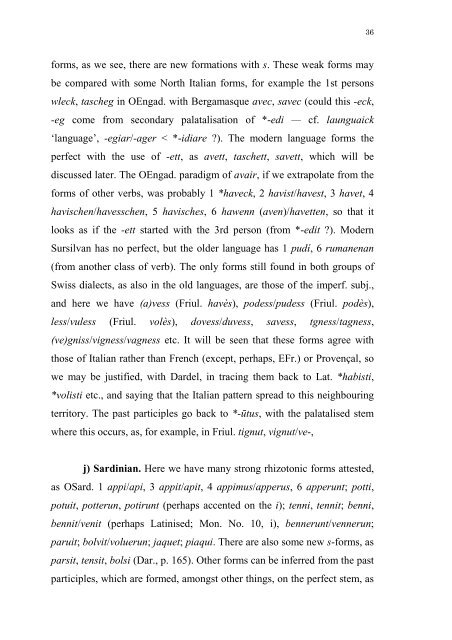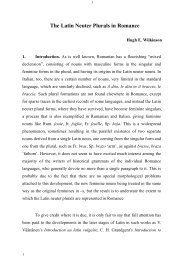THE STRONG PERFECTS IN THE ROMANCE ... - Page ON
THE STRONG PERFECTS IN THE ROMANCE ... - Page ON
THE STRONG PERFECTS IN THE ROMANCE ... - Page ON
You also want an ePaper? Increase the reach of your titles
YUMPU automatically turns print PDFs into web optimized ePapers that Google loves.
forms, as we see, there are new formations with s. These weak forms may<br />
be compared with some North Italian forms, for example the 1st persons<br />
wleck, tascheg in OEngad. with Bergamasque avec, savec (could this -eck,<br />
-eg come from secondary palatalisation of *-edi — cf. launguaick<br />
‘language’, -egiar/-ager < *-idiare ?). The modern language forms the<br />
perfect with the use of -ett, as avett, taschett, savett, which will be<br />
discussed later. The OEngad. paradigm of avair, if we extrapolate from the<br />
forms of other verbs, was probably 1 *haveck, 2 havist/havest, 3 havet, 4<br />
havischen/havesschen, 5 havisches, 6 hawenn (aven)/havetten, so that it<br />
looks as if the -ett started with the 3rd person (from *-edit ?). Modern<br />
Sursilvan has no perfect, but the older language has 1 pudí, 6 rumanenan<br />
(from another class of verb). The only forms still found in both groups of<br />
Swiss dialects, as also in the old languages, are those of the imperf. subj.,<br />
and here we have (a)vess (Friul. havès), podess/pudess (Friul. podès),<br />
less/vuless (Friul. volès), dovess/duvess, savess, tgness/tagness,<br />
(ve)gniss/vigness/vagness etc. It will be seen that these forms agree with<br />
those of Italian rather than French (except, perhaps, EFr.) or Provençal, so<br />
we may be justified, with Dardel, in tracing them back to Lat. *habisti,<br />
*volisti etc., and saying that the Italian pattern spread to this neighbouring<br />
territory. The past participles go back to *-ūtus, with the palatalised stem<br />
where this occurs, as, for example, in Friul. tignut, vignut/ve-,<br />
j) Sardinian. Here we have many strong rhizotonic forms attested,<br />
as OSard. 1 appi/api, 3 appit/apit, 4 appimus/apperus, 6 apperunt; potti,<br />
potuit, potterun, potirunt (perhaps accented on the i); tenni, tennit; benni,<br />
bennit/venit (perhaps Latinised; Mon. No. 10, i), bennerunt/vennerun;<br />
paruit; bolvit/voluerun; jaquet; piaqui. There are also some new s-forms, as<br />
parsit, tensit, bolsi (Dar., p. 165). Other forms can be inferred from the past<br />
participles, which are formed, amongst other things, on the perfect stem, as<br />
36









